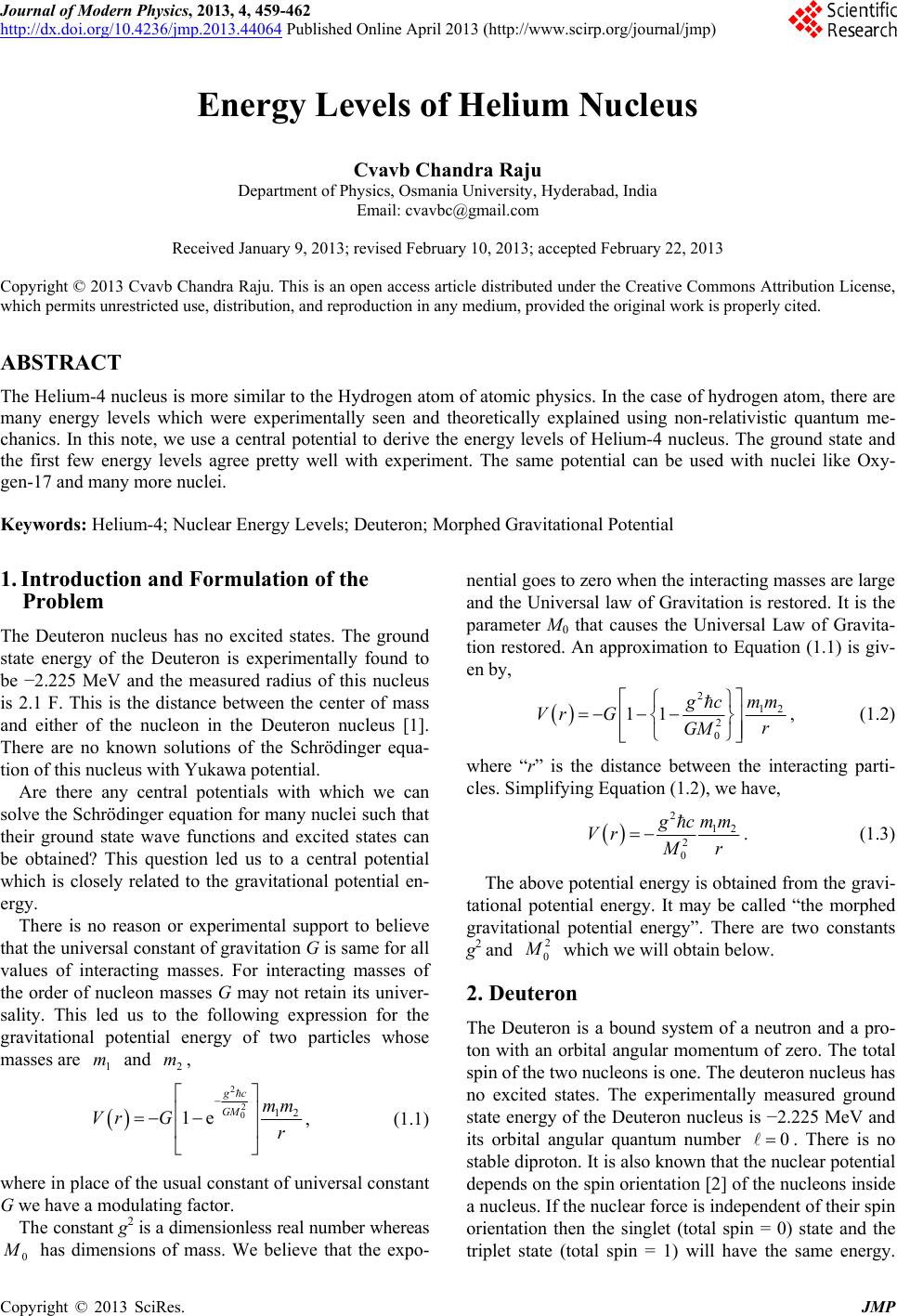
Journal of Modern Physics, 2013, 4, 459-462
http://dx.doi.org/10.4236/jmp.2013.44064 Published Online April 2013 (http://www.scirp.org/journal/jmp)
Energy Levels of Helium Nucleus
Cvavb Chandra Raju
Department of Physics, Osmania University, Hyderabad, India
Email: cvavbc@gmail.com
Received January 9, 2013; revised February 10, 2013; accepted February 22, 2013
Copyright © 2013 Cvavb Chandra Raju. This is an open access article distributed under the Creative Commons Attribution License,
which permits unrestricted use, distribution, and reproduction in any medium, provided the original work is properly cited.
ABSTRACT
The Helium-4 nucleus is more similar to the Hydrogen atom of atomic physics. In the case of hydrogen atom, there are
many energy levels which were experimentally seen and theoretically explained using non-relativistic quantum me-
chanics. In this note, we use a central potential to derive the energy levels of Helium-4 nucleus. The ground state and
the first few energy levels agree pretty well with experiment. The same potential can be used with nuclei like Oxy-
gen-17 and many more nuclei.
Keywords: Helium-4; Nuclear Energy Levels; Deuteron; Morphed Gravitational Potential
1. Introduction and Formulation of the
Problem
The Deuteron nucleus has no excited states. The ground
state energy of the Deuteron is experimentally found to
be −2.225 MeV and the measured radius of this nucleus
is 2.1 F. This is the distance between the center of mass
and either of the nucleon in the Deuteron nucleus [1].
There are no known solutions of the Schrödinger equa-
tion of this nucleus with Yukawa potential.
Are there any central potentials with which we can
solve the Schrödinger equation for many nuclei such that
their ground state wave functions and excited states can
be obtained? This question led us to a central potential
which is closely related to the gravitational potential en-
ergy.
There is no reason or experimental support to believe
that the universal constant of gravitation G is same for all
values of interacting masses. For interacting masses of
the order of nucleon masses G may not retain its univer-
sality. This led us to the following expression for the
gravitational potential energy of two particles whose
masses are and ,
1
m2
m
2
2
012
gc
GM mm
r
0
1eVr G , (1.1)
where in place of the usual constant of universal constant
G we have a modulating factor.
The constant g2 is a dimensionless real number whereas
has dimensions of mass. We believe that the expo-
nential goes to zero when the interacting masses are large
and the Universal law of Gravitation is restored. It is the
parameter M0 that causes the Universal Law of Gravita-
tion restored. An approximation to Equation (1.1) is giv-
en by,
2
12
2
0
11 mm
gc
Vr Gr
GM
,
(1.2)
where “r” is the distance between the interacting parti-
cles. Simplifying Equation (1.2), we have,
2
12
2
0
mm
gc
Vr r
M
2
0
. (1.3)
The above potential energy is obtained from the gravi-
tational potential energy. It may be called “the morphed
gravitational potential energy”. There are two constants
g2 and
which we will obtain below.
2. Deuteron
The Deuteron is a bound system of a neutron and a pro-
ton with an orbital angular momentum of zero. The total
spin of the two nucleons is one. The deuteron nucleus has
no excited states. The experimentally measured ground
state energy of the Deuteron nucleus is −2.225 MeV and
its orbital angular quantum number . There is no
stable diproton. It is also known that the nuclear potential
depends on the spin orientation [2] of the nucleons inside
a nucleus. If the nuclear force is independent of their spin
orientation then the singlet (total spin = 0) state and the
triplet state (total spin = 1) will have the same energy.
0
C
opyright © 2013 SciRes. JMP